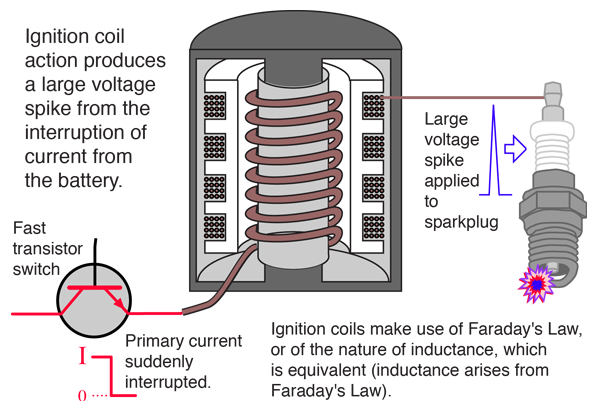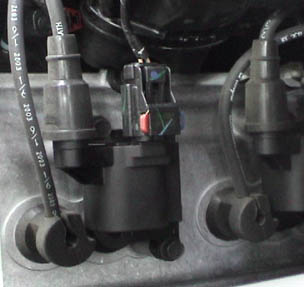Faraday's Law and Auto Ignition
How do you obtain 40,000 volts across a sparkplug in an automobile when you have only 12 volts DC to start with? The essential task of firing the sparkplugs to ignite a gasolene-air mixture is carried out by a process which employs Faraday's law.

The primary winding of the ignition coil is wound with a small number of turns and has a small resistance. Applying the battery to this coil causes a sizable DC current to flow. The secondary coil has a much larger number of turns and therefore acts as a step-up transformer. But instead of operating on AC voltages, this coil is designed to produce a large voltage spike when the current in the primary coil is interrupted. Since the induced secondary voltage is proportional to the rate of change of the magnetic field through it, opening a switch quickly in the primary circuit to drop the current to zero will generate a large voltage in the secondary coil according to Faraday's Law. The large voltage causes a spark across the gap of the sparkplug to ignite the fuel mixture. For many years, this interruption of the primary current was accomplished by mechanically opening a contact called the "points" in a synchronized sequence to send high voltage pulses through a rotary switch called the "distributer" to the sparkplugs. One of the drawbacks of this process was that the interruption of current in the primary coil generated an inductive back-voltage in that coil which tended to cause sparking across the points. The system was improved by placing a sizable capacitor across the contacts so that the voltage surge tended to charge the capacitor rather than cause destructive sparking across the contacts. Using the old name for capacitors, this particular capacitor was called the "condenser".
More modern ignition systems use a transistor switch instead of the points to interrupt the primary current.

The transistor switches are contained in a solid-state Ignition Control Module. Modern coil designs produce voltage pulses up in the neighborhood of 40,000 volts from the interruption of the 12 volt power supplied by the battery.
| Add more annotation to coil diagram |

|
Some modern engines have multiple ignition coils mounted directly on the sparkplugs. Instead of single voltage pulses, they may under some engine conditions produce three voltage pulses. The coil arrangement shown is on a Dodge engine. |  |  |
Faraday's law concepts
Inductance concepts
| HyperPhysics***** Electricity and Magnetism | R Nave |